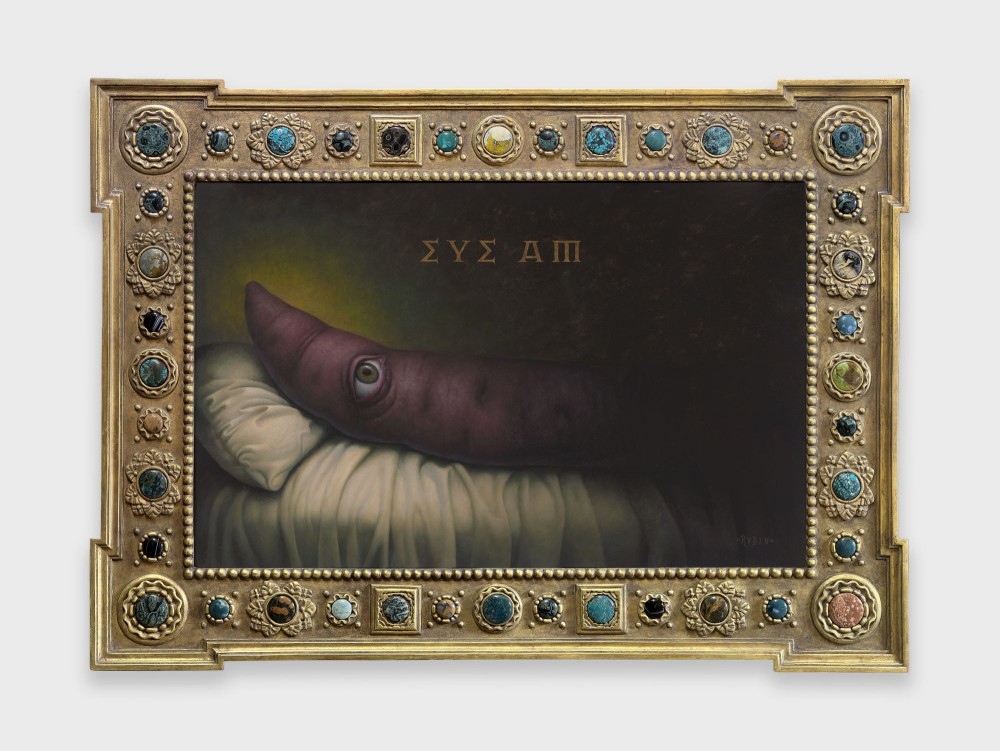
Mark Ryden
“You hide a Sun-powered device in darkness—only if you want to know when it is brought out into the light. In other words, the monolith may be some kind of alarm. And we have triggered it.” —Arthur C. Clarke, 2001: A Space Odyssey, 1968
Perrotin Los Angeles is delighted to present a new solo exhibition by Mark Ryden titled Eye Am. Composed of twelve paintings and a selection of drawings, Eye Am debuts a succinct, eccentric series of mise-en-scènes that resist explanation. Ryden’s worlds, perhaps only a rabbit hole away from our own, run on a separate logic. A wide-eyed Bye-lo Baby, a Tibetan snow lion, an Abe Lincoln chaperon, and, more mirage than flesh, a thin Christ pouring wine for a circle of young girls from his own dripping veins. Sentient, wondrous, and nonsensical entities inhabit the works.
One tubular figure, a yam perhaps, lies in bed at night, keeping vigil; the sheets retain a quality of Philippe de Champaigne’s Ex-Voto (1662), a painting of the artist's paralyzed daughter miraculously healed in a convent. With the ornate frame inseparable from the body of the canvas, Ryden’s figure stares with a single eye at the exhibition’s title written above, as if aware of its own summoning. Eye Am: the words emboss and disguise a yam in plain sight. In a later work, a yam floats upright over a dreamscape. The sedentary self and, later, the higher self. The yam is a curious medium, echoing the fetuses and internal organs that recur across Ryden’s work. The medium signals fertility, or perhaps commodity—“medium yams, 25 cents a pound”—or even a continued exploration of the partition between body and spirit.
Much is formed in darkness, down in a certain country of dreams. In soil. In the womb. In sleep. In scripture, before there was light. Take the pineal gland. Detectable at three weeks, it is the first gland formed in the fetus; later, this tiny pinecone-shaped organ releases melatonin in darkness, telling the body to sleep. It is the only part of the brain without a pair. Descartes called it the “seat of the soul,” and in Yogic teachings it aligns with the Ajna chakra, “the third eye.”
The seat of the soul. The rice-sized force field they can’t breach.
In Ryden’s 177th painting, The Sentinel (2024), a single eye looks out from a mysterious object onto a field now covered with wild flowers. A bee, curious by the hush of her tiny, febrile moan, looks back. The title itself trips. It trips, another small synchronicity: only after naming the work did Ryden learn that The Sentinel (1951) by Arthur C. Clarke was the story that inspired the film 2001: A Space Odyssey (1968) and much science fiction since. Where did this watchtower come from, before the lake fell still and the third eye Mark Ryden, Eye Am #181, 2024. Oil on panel in hand-carved wood frame. Unframed: 19 x 30 inches, framed: 29 x 40 1/4 x 2 inches. Courtesy of the artist, Perrotin, and Kasmin. opened on this strange world? Better not answer. Not that I know. Best not spoil the illusion.
– Paige Haran